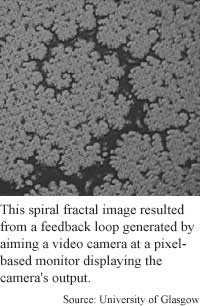
Pixel
feedback forms fractals
By
Kimberly Patch,
Technology Research NewsWhat does a video screen look like when the camera generating the picture is pointed at the screen? It all depends on the type of screen you are using and how much of the screen is in the camera's field of view.
Scientists from the University of Glasgow in Scotland have produced fractal images using screens that have pixels and cameras that are focused on only a small portion of the screen.
The finding promises to improve researchers' understanding of fractals, which are very common in nature, and of feedback, which is common to many systems.
The patterns, including classic fractals like the von-Koch snowflake and the Sierpinski gasket, emerge because as the camera records a small part of the screen, it picks up individual pixels, said Johannes Courtial, a research fellow at the University of Glasgow. "The camera is connected to the monitor, so the monitor displays a magnified image of part of its own pixel pattern," he said.
As time goes on the monitor displays the original, small-scale, pixel pattern, plus an increasing number of increasingly magnified pixel patterns. "The presence of the same pattern in different sizes is... a hallmark of fractals," said Courtial.
The exact fractal pattern depends on the geometry of the pixel array being magnified, the shape and size of the individual pixels, how much the pattern is magnified, and where the magnified view is centered within the pixel array, according to Courtial.
The classic way to make a von-Koch snowflake fractal is to start with a line, then replace the middle portion of the line with an upside-down V to make four connected lines, then replace the middle portion of each of the four lines with an upside-down V to make 16 connected lines. Continuing this action results in an increasingly complicated snowflake-like pattern with self-similar features, meaning that the same patterns appear in both larger and smaller portions of it.
The Sierpinski gasket is made by putting an upside-down triangle inside a larger, right-side-up triangle so the points of the smaller triangle touch the sides of the larger triangle, resulting in four equal triangles, then repeating the process many times.
Most fractal generation processes start off with large-scale structures and create smaller and smaller units. "The process we describe starts off with a small-scale pattern and creates successively larger structures from this," said Courtial.
The key to finding fractals in pixelated monitors turned out to be the technical trick of taking the average of a few frames to get rid of the monitor's flicker, he said.
The finding is part of a pattern found throughout many processes, including plant growth and coastline erosion. Fractals are "one of the fundamental design principles of nature. Ferns, trees, clouds and mountains are some examples of fractals in nature," Courtial said.
The researchers have found a new way to generate fractal images, said Michael Frame, a professor of mathematics at Yale University. "This video feedback process uses expansion and pixelation in an interesting combination. Associated with any [generation] method are a collection of natural mathematical questions. I've not seen this approach before, so I believe it adds another avenue to fractal geometry," he said.
"This is a fascinating phenomenon that has been known of for at least 20 years and has been rarely, if ever, studied with care. It is novel in that the authors are making some attempt to study this systematically," said Chaim Goodman-Strauss, an associate professor of mathematics at the University of Arkansas.
Although there probably are not many direct applications for the research in the near future, it may eventually help further the general understanding of feedback and fractals, said Goodman-Strauss. "Feedback is a feature of many complex natural systems. Virtually every branch of the modern sciences has some subfield that is immersed in the study of some sort of feedback and the complexity it produces. This will be even more true over the coming decades."
The researchers are working to apply the principles they have learned from video feedback to lasers in order to both understand lasers better, and be able to form pretty patterns with lasers, said Courtial. "Perhaps we can build a laser with a beam in the shape of a von-Koch snowflake," he said.
Courtial's research colleagues were Jonathan Leach and Miles J. Padgett. They published the research in the December 20/27, 2001 issue of Nature. The research was funded by England's Engineering and Physical Sciences Research Council (EPSRC) and the Royal Society in London.
Timeline: Now
Funding: Government
TRN Categories: Chaotic Systems, Fuzzy Logic and Probabilistic Reasoning; Graphics
Story Type: News
Related Elements: Technical paper, "Fractals in Pixelated Video Feedback," Nature, December 20/27, 2001.
Advertisements:
January 2, 2002
Page One
Printed pictures hide images
Quantum demo does tricky computing
Email burdened by management role
Pixel feedback forms fractals
Software agents evolve purpose

News:
Research News Roundup
Research Watch blog
Features:
View from the High Ground Q&A
How It Works
RSS Feeds:
News
Ad links:
Buy an ad link
| Advertisements:
|
 |
Ad links: Clear History
Buy an ad link
|
TRN
Newswire and Headline Feeds for Web sites
|
© Copyright Technology Research News, LLC 2000-2006. All rights reserved.